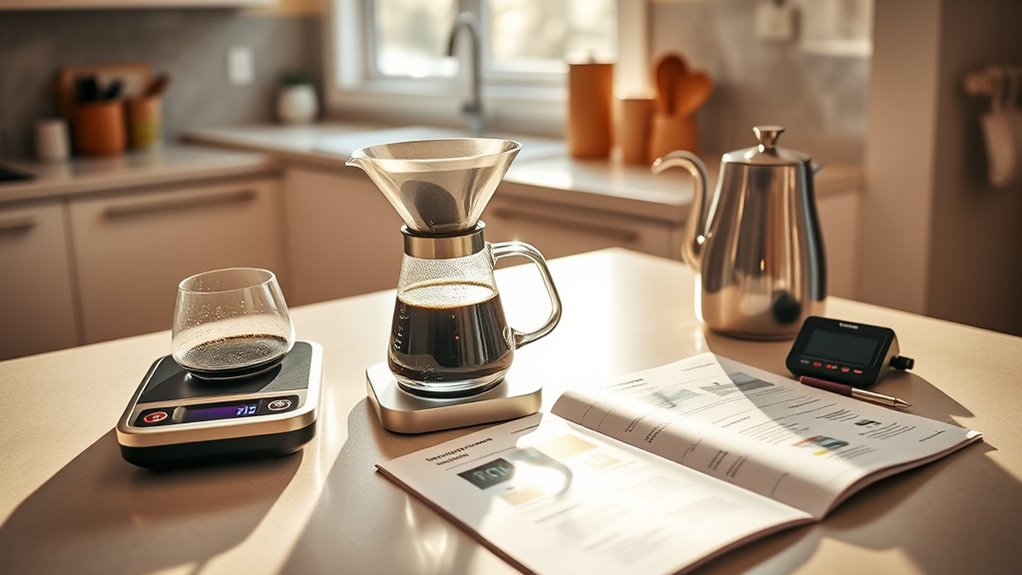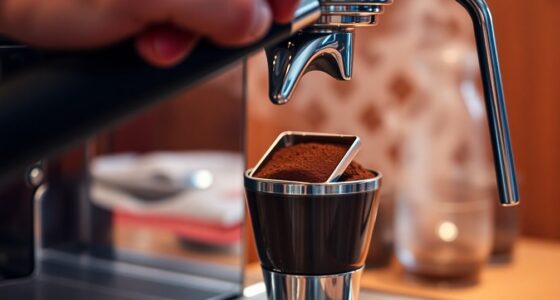To troubleshoot brew time issues, start by checking your grind size—finer grinds increase resistance, slowing brewing, while coarser ones might cause under-extraction. Make sure your water temperature stays between 195°F and 205°F for ideal extraction. Regularly clean and descale your machine to prevent mineral buildup, and verify all settings match the manufacturer’s recommendations. If delays persist, there are more detailed steps to fine-tune your coffee maker’s performance that you’ll find helpful.
Key Takeaways
- Check and adjust grind size to prevent excessive resistance or under-extraction affecting brew time.
- Ensure water temperature is within 195°F to 205°F for optimal extraction speed.
- Use clean, filtered water and regularly descale to avoid mineral buildup that delays brewing.
- Verify machine settings like brew time and strength match manufacturer recommendations.
- Perform routine maintenance and replace outdated units if persistent issues or hardware problems occur.
Understanding Your Coffee Maker’s Brewing Process
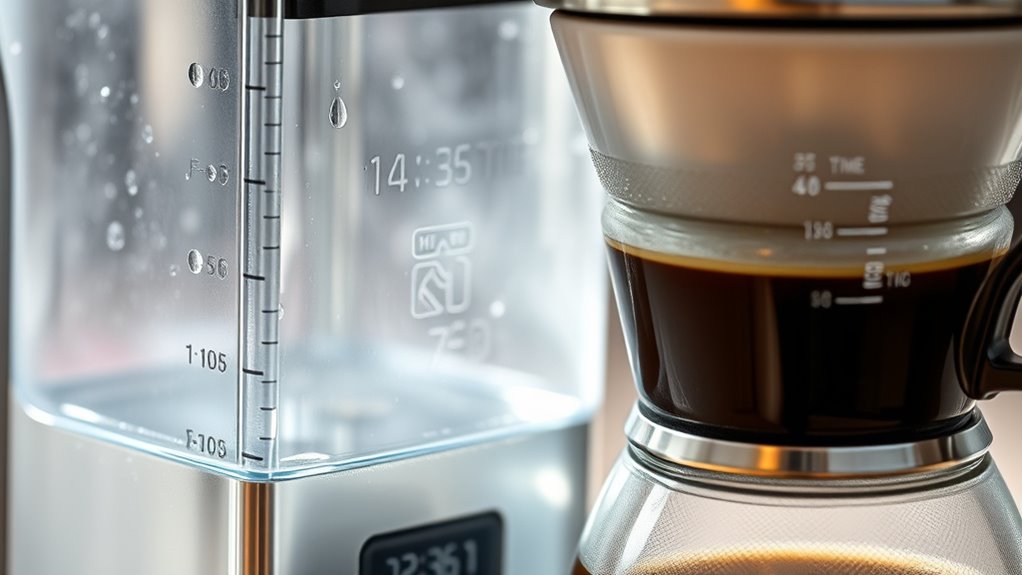
Understanding how your coffee maker brews coffee is essential for troubleshooting time issues. The process begins with your coffee grind; a finer grind increases resistance, slowing water flow, while a coarser grind speeds it up. Water temperature also plays a key role—water that’s too hot can extract flavors quickly, but it may cause delays if the machine struggles to reach the ideal temperature. Conversely, water that’s too cool can result in under-extraction and extended brewing times. Knowing how these factors interact helps you identify potential problems. For example, if your grind is too fine or the water isn’t heating properly, your brew time will increase. Additionally, the type of water used can affect brewing efficiency and flavor extraction. By understanding these core aspects, you can better diagnose why your coffee maker isn’t working efficiently.
Common Causes of Slow or Inconsistent Brew Times
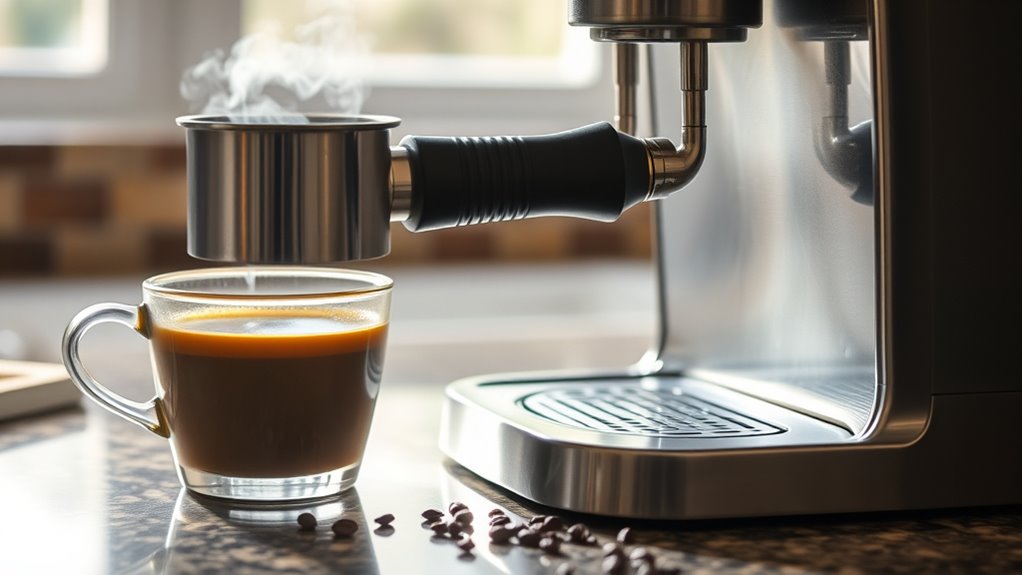
If your coffee takes longer than usual to brew or the timing varies each time, several common issues could be at play. One major factor is grind size; if your beans are too fine, water struggles to pass through, slowing down the brew. Conversely, a too-coarse grind can cause under-extraction and inconsistent timing. Water temperature also plays a role—if the water isn’t hot enough, it heats more slowly, delaying extraction. Inconsistent water temperature can lead to irregular brew times. Additionally, using old or stale beans can affect extraction rates. Ensuring your grind size is appropriate for your machine and maintaining ideal water temperature are key steps to achieving a steady, efficient brew process. Regular adjustments can help eliminate these common causes of slow or inconsistent brew times. Speaks 4 Me Online
How to Check and Adjust Your Machine’s Settings

To guarantee your coffee brews consistently, start by checking your machine’s basic settings. Ensure the grind size is appropriate; a too-fine grind can slow down extraction, while a coarse grind might cause weak flavor. Adjust the water temperature to match your preferred brew style—ideally between 195°F and 205°F for ideal extraction. Verify the brew time setting on your machine, making sure it matches the recommended duration. Additionally, check for any user-adjustable features such as brew strength or pre-infusion options that might influence timing. Exploring AI-driven solutions in coffee technology may also enhance your brewing precision.
Maintenance Tips to Keep Your Coffee Maker Running Smoothly

Regular maintenance is essential to guarantee your coffee maker continues to perform at its best. To keep it running smoothly, pay attention to water quality and stick to regular descaling routines. Hard water can cause mineral buildup, leading to longer brew times and potential damage. Using filtered water reduces this risk. Descaling removes mineral deposits that hinder performance. Here’s a quick overview:
| Maintenance Tip | Benefit |
|---|---|
| Use filtered water | Prevents mineral accumulation |
| Regular descaling routines | Keeps internal components clean and efficient |
| Clean removable parts | Ensures consistent brewing and flavor |
| Wipe down exterior | Maintains overall hygiene and appearance |
Following these simple steps ensures your coffee maker stays in top shape, delivering great brew times every time. Additionally, monitoring your machine’s performance can help identify early signs of issues before they affect brew quality.
When to Seek Professional Help or Consider Replacement
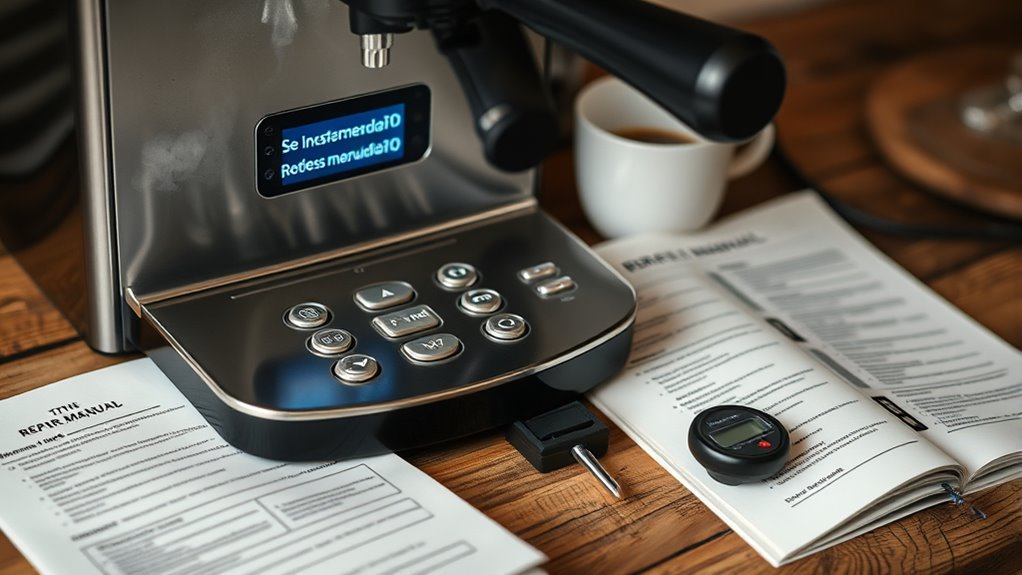
Sometimes, despite your best maintenance efforts, your coffee maker may start to show signs that it’s time to seek professional help or consider replacing it. If troubleshooting no longer resolves issues like persistent brewing delays or inconsistent temperature, it’s a clear sign. You might also notice frequent breakdowns, strange noises, or leaks that point to serious hardware problems requiring expert assessment. Consider hardware upgrades if your model is outdated or lacks modern features. Check if your device is still under warranty, as repairs or replacements could be covered. When repair costs approach or exceed the price of a new unit, replacement becomes the smarter choice. Recognizing these signs ensures you don’t waste time and energy on futile repairs and keeps your coffee routine running smoothly. Additionally, website performance metrics and user feedback can help determine if it’s time to upgrade your appliance.
Frequently Asked Questions
Can Different Coffee Beans Affect Brew Time?
Yes, different coffee beans can affect brew time because factors like bean freshness and roast level matter. Fresh beans tend to release flavors faster, potentially reducing brewing time. Darker roasts usually require less brewing time than lighter roasts due to their grind and density differences. So, when switching beans, you might need to adjust your brew time slightly to achieve the perfect flavor.
Does Altitude Impact a Coffee Maker’s Brewing Speed?
Altitude effects your coffee’s brew time by lowering boiling points—water boils at 198°F instead of 212°F at high elevations, slowing extraction. This can be affected by bean roast and water mineralization, which influence heat transfer. Filter material and ambient temperature also play roles, as they impact water flow and heat retention. You might notice longer brew times at higher altitudes, so adjusting grind size or brew methods can help optimize your coffee.
How Does Water Quality Influence Brew Time?
Water quality directly affects your brew time. High mineral content in water, like calcium and magnesium, can cause mineral buildup in your coffee maker, slowing down the process. Additionally, water pH levels influence extraction; overly acidic or alkaline water may lead to longer brewing times or inconsistent results. Using filtered water with balanced mineral content and neutral pH helps your machine operate efficiently, ensuring a quicker, more consistent brew.
Are There Specific Filters That Slow Down Brewing?
Imagine your coffee maker slowing down unexpectedly. This often happens because of filter clogging caused by certain filter materials. For example, paper filters with fine pores can trap grounds and debris, reducing water flow. When the filter material isn’t designed for efficient flow, it slows down brewing. To avoid this, choose filters made from thicker or more porous materials, which allow water to pass through more quickly without clogging.
Can Ambient Temperature Affect Coffee Extraction Speed?
Yes, ambient temperature can affect your coffee extraction speed. Temperature fluctuations in your environment influence how quickly water heats and interacts with coffee grounds. If your equipment isn’t properly calibrated for these changes, it may brew too fast or slow. To maintain consistent extraction times, monitor ambient conditions and regularly calibrate your equipment, ensuring stable brewing results regardless of temperature shifts.
Conclusion
Mastering your coffee maker’s quirks guarantees your mornings stay flawless, turning every brew into a symphony of flavor. With a keen eye and routine maintenance, you’ll avoid the chaos of a sluggish machine—saving you from the chaos of a caffeine catastrophe. When troubleshooting feels overwhelming, remember that a well-tuned brewer can last for years, transforming your daily ritual into a legendary experience. Take charge, and never let a slow brew steal your morning magic.
